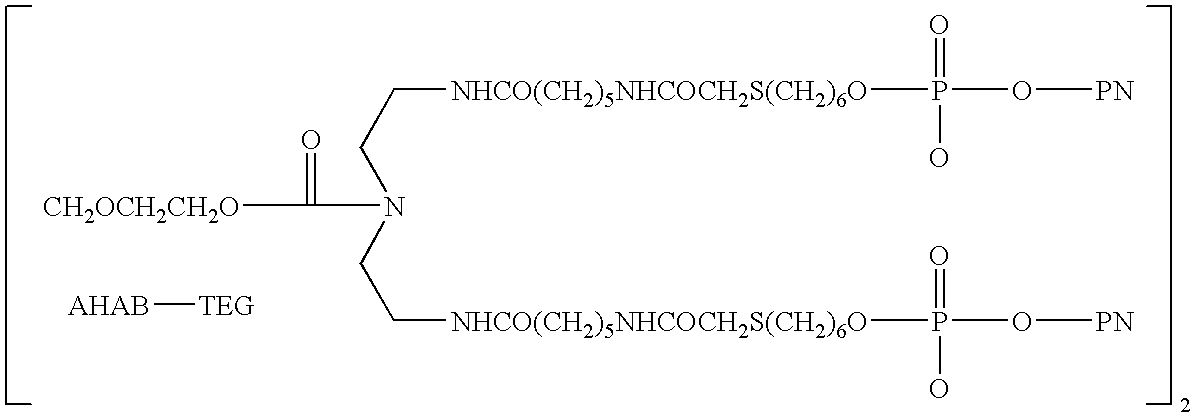Methods of treating proteinuria by reducing double-stranded DNA antibodies
- Summary
- Abstract
- Description
- Claims
- Application Information
AI Technical Summary
Benefits of technology
Problems solved by technology
Method used
Image
Examples
example 1
SLE Patient Population Treated with LJP394
[0196] A study was conducted in patients who met American College of Rheumatology criteria for the diagnosis of SLE, had a previous episode of SLE renal disease within four years, and had elevated anti-dsDNA≧15 IU / mL by the Farr assay at time of enrollment (Tan E M, et al. (1982) Arthritis Rheum 25:1271-7). Patients were excluded if they had evidence of a renal flare within three months of screening; were receiving prednisone or prednisone equivalent>20 mg / day, azathioprine>200 mg / day, methotrexate>25 mg / wk and / or cyclophosphamide at any dose within three months of screening; or a serum creatinine level≧2.5 mg / dL. The study was conducted in the US and Europe according to Good Clinical Practices and all patients provided voluntary informed consent.
[0197] A pharmacodynamic assay has been developed to measure the binding affinity of patients' anti-dsDNA antibodies to LJP 394 (Sem D S, et al. (1999) Arch Biochem Biophys 372:62-8; McNeeley P A,...
example 2
Treatment of SLE Patients with LJP394 (Phase 2 / 3, 90-05 and Phase 3, 90-09 Studies)
[0198] Two randomized, placebo-controlled trials were carried out in SLE patients. The Phase 2 / 3 study (referred to as the 90-05 study) enrolled 230 patients (114 LJP394 and 116 placebo) (ALL). Among them, 189 patients (92 LJP394 and 97 placebo) were within the high affinity subgroup (HA). The patients were treated for up to 18 months. Patients were randomized to receive LJP394 100 mg as a 2 m bolus intravenous injection on a weekly basis or placebo for 16 weeks. This was followed by 8-week off treatment period with 12 weekly treatment with 50 mg (1 ml bolus injection) LJP394 or placebo. The first 16 weeks, when patients received 100 mg LJP394 or placebo weekly, was considered the “induction period,” followed by “maintenance,” when patients alternated 8-week off and 12 weeks of treatment. The 20 week cycles were repeated three times for a total of 60 weeks.
[0199] The Phase 3 study (referred to as th...
example 3
Determination of Proteinuria Reduction in Patients Treated with LJP394 and Placebo
[0200] Proteinuria was measured by analyzing the 24 hour urine collection of the patients. Protein concentration was determined using an assay kit purchased from Wako Pure Chemistry Co., Ltd.
[0201] Changes in proteinuria were analyzed for patients who had 24 hour urine collection both at baseline and at approximately one year using logistic regression. The result of the analysis is summarized in Table 1. In the 90-05 study, 44% (27 / 61) of patients in the LJP394 treated group demonstrated a 50% or greater reduction in 24-hour urine protein from baseline at one year compared to 19% (12 / 63) in the placebo group (nominal p=0.003). Among patients in the high affinity subgroup, 46% (24 / 52) of patients in the LJP394 treated group demonstrated a 50% or greater reduction in 24-hour urine protein from baseline at one year compared to 18% (11 / 61) in the placebo group (nominal p=0.001). In the 90-09 study, 40% (...
PUM
| Property | Measurement | Unit |
|---|---|---|
| Fraction | aaaaa | aaaaa |
| Fraction | aaaaa | aaaaa |
| Time | aaaaa | aaaaa |
Abstract
Description
Claims
Application Information
 Login to View More
Login to View More - R&D
- Intellectual Property
- Life Sciences
- Materials
- Tech Scout
- Unparalleled Data Quality
- Higher Quality Content
- 60% Fewer Hallucinations
Browse by: Latest US Patents, China's latest patents, Technical Efficacy Thesaurus, Application Domain, Technology Topic, Popular Technical Reports.
© 2025 PatSnap. All rights reserved.Legal|Privacy policy|Modern Slavery Act Transparency Statement|Sitemap|About US| Contact US: help@patsnap.com



